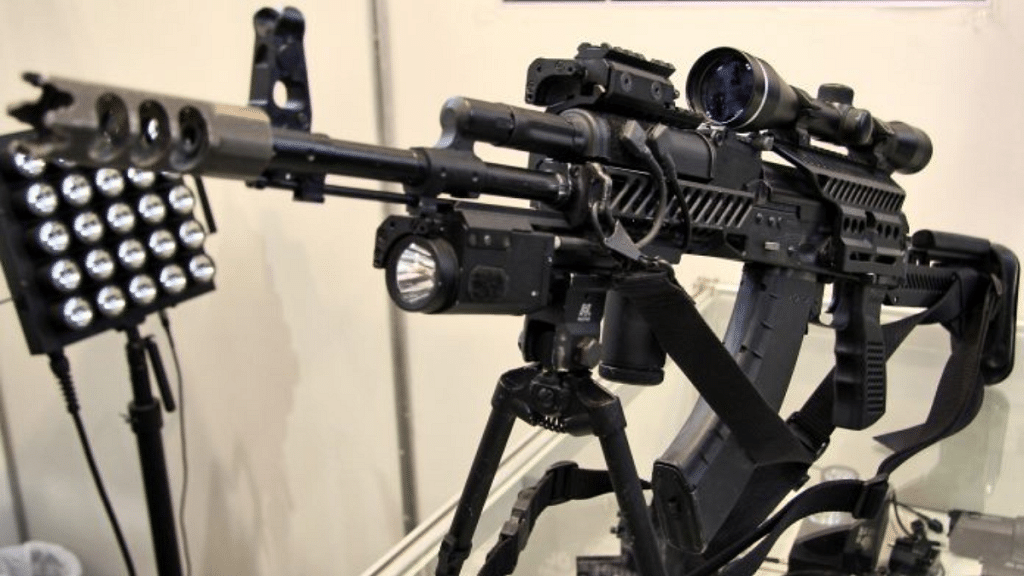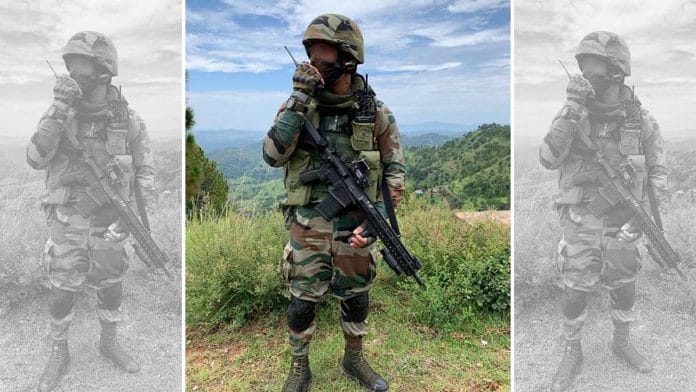The Indian Army’s additional order of 73,000 SIG Sauer 716 G2 rifles, at a cost of Rs 840 crore, or $100 million, under emergency procurement has triggered a spate of articles on India’s never-ending quest for a state-of-the-art rifle. For this order, placed last month after the 72,400 ordered in 2019, the government was berated for flouting its policy of Atmanirbharta in defence, under which the import of small arms is banned.
The armed forces have for long been roasted for their ever-changing “Marvel comics”-style General Staff Qualitative Requirements (GQSRs), while the Defence Research and Development Organisation (DRDO) has come under fire for failing to develop an indigenous rifle. In the current instance, private defence manufacturer Vivek Krishnan, CEO of SSS Defence, too jumped into the fray, criticising the government for ignoring “made in India” weapons and throwing a challenge to test his rifle against global benchmarks.
Given the Army’s 17-year-old quest for a state-of-the-art rifle, which began in 2007, all of the above are guilty as charged. However, in all fairness, the current problems stem mostly from the poor management of the India-Russia joint production of AK-203 rifles under “Make in India”, coupled with the urgent need of the Army to equip minimum essential frontline troops with a cutting-edge rifle to replace the unreliable INSAS rifle. More so, when adversaries, including terrorists, were armed with better weapons.
Also Read: Could Stryker & Javelin deals hit defence atmanirbharta? Not if we play our cards right
A chequered past
Over the past 129 years, the Indian Army has been equipped with three types of modern rifles. The British Lee Enfield .303 calibre rifle was introduced in 1895 and its various progressive versions remained in service for 70 years until the mid-1960s. The second rifle, the L1A1 7.62 mm self-loading rifle (semi-automatic), the British version of the famous Belgian FN-FAL 7.62 mm self-loading rifle, was introduced in the mid-1960s, remaining in service for 40 years. This weapon was manufactured under licence in India. The third rifle, the indigenous 5.56 calibre Indian Small Arms System (INSAS), was progressively introduced into service with effect from 1999.
The INSAS was based on the legendary AK-47 assault rifle, 250,000 units of which had been procured off the shelf in the late 80s and 90s as an interim measure for counter-insurgency operations to match the weaponry of the terrorists. From the very outset, the INSAS rifle has had a host of technical problems due to its flawed design, sub-standard metallurgy, and poor quality control during mass production. Despite the best efforts of the DRDO and ordnance factories to eradicate these problems, it lost the confidence of the infantry soldier—a very dangerous situation that affects morale and fighting capabilities in battle. In 2007, it was decided to replace the INSAS with a next-gen rifle.
The next 10 years, however, were wasted due to the Army’s unrealistic GSQRs and its failure to standardise the calibre. So much so that it became the laughing stock of the world for specifying a rifle with two barrels—one to fire the 5.56 mm NATO round and the other for the 7.62 mm Russian round due to its perceived higher penetration. By 2000, rifle technology had reached its optimum level. All weapons produced thereafter have only been upgraded designs of both the rifle and the ammunition. The DRDO was unable to match the quality of NATO or Russian rifles due to dated technology and poor metallurgy.
The best approach for the Army was to manufacture a proven rifle under licence, with absolute transfer of technology, including future design improvements and development. It’s to the government’s credit that it took the bull by the horns in 2018 and decided to manufacture the Russian AK-203—the latest rifle designed by Russia’s Kalashnikov Concern. In January 2019, an Intergovernmental Agreement (IGA) was signed between India and Russia.
But just prior to the decision to manufacture the AK-203, it was decided to import 72,400 SIG 716 rifles as a one-time measure for frontline troops, mainly to address morale issues arising from the perception that their rifles were inferior to those used by terrorists. Further immediate needs were to be met through direct imports of AK-203 rifles.
Correct approach, tardy execution
On 3 March 2019, Prime Minister Narendra Modi laid the foundation stone of the manufacturing unit for the AK-203 assault rifle in Amethi’s Ordnance Factory Board (OFB) facility, rightly taking credit for the initiative ahead of the parliamentary elections. However, the project soon became mired in contract negotiations, specifically with respect to the cost of transfer of technology and the high royalty per rifle. The situation was further compounded by the higher-than-expected production cost per unit quoted by the OFB.

It took two years to finalise the contract, which was finally cleared by the Defence Acquisition Council, chaired by the Defence Minister, on 23 November 2021. Indo-Russia Rifles Private Limited was established as a joint venture between OFB (with a 50.5 per cent majority stake), Kalashnikov (42 per cent), and Rosoboronexport (7.5 per cent), Russia’s state-owned defence export agency. Through this joint venture, the rifles are to be manufactured at the Korwa Ordnance Factory in Amethi district of Uttar Pradesh. Under the contract, more than 6 lakh AK-203 rifles will be produced in India, with an unspecified number to be imported directly from Russia. The details of progress are unclear and it is likely that supply has been impacted by Russia’s own needs for the Ukraine war. However, ThePrint reported in 2021 that 70,000 rifles were imported by the Indian Air Force under emergency procurement.
Manufacturing of the AK-203 finally took off in July this year, with 35,000 rifles delivered to the Indian Army. The rate of production per year is not in the public domain. In my view, it would take a minimum of five years before the entire Army is equipped. It is expected that the scope of the contract will be widened to cater for the needs of the IAF, Indian Navy, and the Central Armed Police Forces (CAPFs).
It is in light of this that the additional order for the SIG 716 rifles should be seen. It is simply not logistically practical for Indian manufacturers to meet this demand on their own.
Quality control
The DRDO and Defence Public Sector Undertakings have long been notorious for poor quality control during mass production. This is true even for equipment manufactured under licence after the transfer of technology. Having commanded mechanised force at all levels, it is my experience that in the case of the ICV BMP-2 and the T-90 tank, there was a 25 per cent drop in quality compared to direct imports.
The INSAS rifle had cleared the Army’s stringent field trials before its induction. It was a good rifle that could have been refined further. Its downfall came from poor metallurgy and lacklustre quality control during mass manufacturing. Soldiers lost confidence in it due to its unreliability and this, in turn, magnified all other shortcomings—which were relative and could have been improved in later versions.
I am keeping my fingers crossed that the AK-203 does not meet the same fate and that Russian commercial participation ensures the maintenance of the world-famous Kalashnikov reliability.
Also Read: DRDO-L&T’s Zorawar a proud light tank project for Army. It must remain relevant for next 30 yrs
Man behind the gun
The technical proficiency of any rifle ultimately translates into combat effectiveness through the skill of the man wielding it. However, soldiers the world over are notorious for poor marksmanship. According to US Army statistics, it’s estimated that in conventional wars, 25,000 rounds were fired to kill one enemy soldier in World War II, 50,000 in the Korean War, and 200,000 with the advent of automatic rifles in Vietnam.
My estimate for counter-insurgency operations in Jammu & Kashmir is that 3,000 to 5,000 rounds are fired for each terrorist killed. While the stress of combat and the need to minimise casualties using a large volume of suppressive fire are justifiable reasons, poor marksmanship standards and the failure to make the rifle an extension of the body are major contributing factors. The marksmanship standards of our soldiers are below average, mainly due to poor training methods, a lack of simulators, and a shortage of ranges.
Marksmanship is the most important factor in infantry combat. It requires theoretical training to understand the theory of small arms, practical training in handling the weapon to make it an extension of the body, zeroing (aligning the sight with the barrel), firing on ranges, and shooting under combat conditions. We do not allocate adequate training time, and most soldiers do not understand the theory of small arms and cannot zero their own rifles.
Each unit used to have a short range within unit areas, but these have fallen into disuse or disappeared altogether. Long ranges, which require a 3 km by 1 km area, have been encroached upon and gone into disuse. Baffle ranges to replace these are too few, giving inadequate time to infantry units to train. Very few simulators are authorised, and those that exist are of the previous generation. Field firing ranges are inadequate to practice combat shooting. The three battle schools of Northern Command are notable exceptions for realistic combat shooting. These need to be replicated in all formations.
The future rifle of the armed forces is the state-of-the-art AK-203. The government and armed forces must ensure that production reaches its designated levels at the earliest. Above all, quality control must be ensured.
Lt Gen H S Panag PVSM, AVSM (R) served in the Indian Army for 40 years. He was GOC in C Northern Command and Central Command. Post retirement, he was Member of Armed Forces Tribunal. Views are personal.
(Edited by Asavari Singh)






